Welcome to My Gardens Bloom! Today, we’re exploring the enchanting world of grape hyacinths. These charming spring bloomers, known for their dense clusters of tiny, bell-shaped flowers, can add a burst of color and beauty to your garden. Whether you are a seasoned gardener or just starting out, grape hyacinths are a delightful addition that requires minimal care yet offers maximum visual impact. In this comprehensive guide, we’ll dive deep into the fascinating aspects of grape hyacinths, covering their history, varieties, planting techniques, care tips, and creative uses in your garden.
What Are Grape Hyacinths?
Grape hyacinths (genus Muscari) are perennial bulbous plants belonging to the asparagus family (Asparagaceae). They are native to Eurasia, primarily the Mediterranean region, and are cherished for their beautiful clusters of small, tubular flowers that resemble a bunch of grapes. The most common variety is Muscari armeniacum, which features vibrant blue flowers, but there are also varieties with white, pink, and yellow blooms.
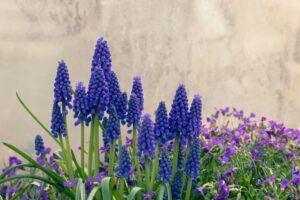
The name “Muscari” is derived from the Greek word for musk, referencing the slight fragrance some species produce. Grape hyacinths have been cultivated for centuries, often appearing in cottage gardens and wildflower meadows across Europe. Their hardiness and ease of care have made them a favorite among gardeners worldwide.
Plant Description
The flowers of grape hyacinths are small, tubular, and bell-shaped, typically measuring about 0.25 inches (6-7 mm) in diameter. They grow in dense, spike-like clusters (racemes) that can reach up to 8 inches (20 cm) in length. The most common flower color is a vibrant cobalt blue, but varieties also come in shades of white, pink, and yellow. Some species and cultivars produce a faint, musky fragrance, adding an extra sensory dimension to their visual appeal. Grape hyacinths typically bloom in early to mid-spring, often from March to May, depending on the climate and specific variety.
The leaves of grape hyacinths are narrow, strap-like, and grass-like, emerging from the base of the plant. They are usually about 6-12 inches (15-30 cm) long and form a basal rosette. The leaves are bright green and remain attractive throughout the growing season, even after the flowers have faded.
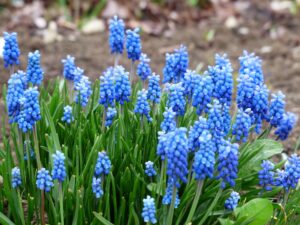
Grape hyacinths grow from small, ovoid bulbs that are about 0.5-1 inch (1.5-2.5 cm) in diameter. The bulbs produce offsets, or small daughter bulbs, which can be separated and replanted to propagate new plants.
Grape hyacinths are low-growing plants that reach a height of 6-12 inches (15-30 cm) when in bloom. They spread gradually through bulb offsets, forming dense clumps over time. This naturalizing ability makes them an excellent choice for creating carpets of color in garden beds, borders, and lawns.
Varieties of Grape Hyacinths
Common Varieties
Muscari armeniacum: The most popular and widely grown species, known for its striking cobalt blue flowers.
Botryoides Muscari: Features slightly larger flowers in shades of blue and white.
Muscari comosum: Known as the tassel hyacinth, with unique tassel-like flowers.
Muscari aucheri: Produces dense clusters of sky-blue flowers with white tips.
Specialty Varieties
‘Pink Sunrise’: A unique variety with delicate pink flowers.
‘White Magic’: Pure white flowers that add elegance and contrast to garden plantings.
‘Golden Fragrance’: Features yellow flowers and a sweet fragrance, adding a different hue and scent to your garden.
Sunlight Requirement of Grape Hyacinths
Grape hyacinths thrive in full sun to partial shade. Select a location that receives at least 4-6 hours of direct sunlight daily. In hotter climates, providing some afternoon shade can help protect the plants from excessive heat.
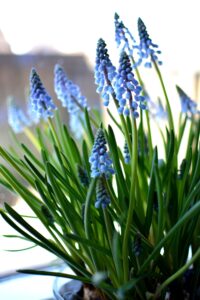
Temperature and Humidity Requirement
Grape hyacinths are hardy in USDA zones 3-9, making them suitable for a wide range of climates. They can tolerate cold winters and are often among the first flowers to emerge in spring. In hotter climates, they may benefit from some afternoon shade to protect them from extreme heat.
Soil Requirements
These plants prefer well-drained soil that is moderately fertile. Grape hyacinths prefer slightly acidic to neutral soil with a pH of 6.0 to 7.0. Use a soil test kit to determine your soil’s pH and amend it if necessary. If your soil is heavy or clay-like, mix in organic matter such as compost or well-rotted manure to improve drainage and fertility. Use a garden fork or tiller to loosen the soil to a depth of about 6-8 inches (15-20 cm).
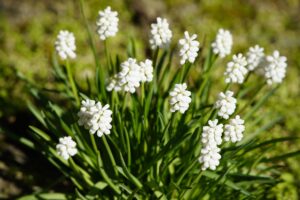
Propagation of Grape Hyacinths
Division
Grape hyacinths naturalize easily and can form large clumps over time. To propagate, lift and divide the clumps of bulbs every few years in the fall after the foliage has died back. Replant the divisions at the appropriate depth and spacing.
Offsets
Small bulbs, or offsets, form around the base of the main bulbs. These can be separated and replanted to create new plants. Here’s how to do it:
Carefully dig up the bulbs after the foliage has died back.
Gently separate the offsets from the main bulbs.
Replant the offsets in prepared soil at the same depth as the original bulbs.

Planting of Grape Hyacinths Bulb
Plant grape hyacinth bulbs in the fall, about 6 weeks before the first expected frost. This timing allows the bulbs to establish roots before the ground freezes.
Dig holes or a trench 3-4 inches (7-10 cm) deep.
Space the bulbs about 2-3 inches (5-8 cm) apart.
Place the bulbs in the holes with the pointed end facing up. Cover with soil and firm gently.
Water the bulbs thoroughly after planting to help them settle in and establish roots.
Watering
Keep the soil evenly moist but not waterlogged during the growing season (spring and early summer). Reduce watering after the foliage dies back in late spring or early summer. The bulbs are dormant during this time and do not require much water.
Fertilization
Grape hyacinths generally do not require heavy fertilization. However, you can apply a balanced, slow-release fertilizer in early spring as new growth emerges to give them a boost.
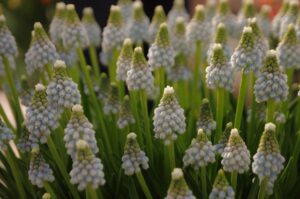
Deadheading and Pruning
Remove spent flowers to prevent the plants from setting seed. This encourages the bulbs to store energy for the next year’s blooms.
Allow the foliage to die back naturally. The leaves gather energy through photosynthesis, which is stored in the bulbs for next season’s growth. Avoid cutting back the leaves too soon.
Troubleshooting Common Issues
Bulbs Not Flowering: This can be due to overcrowding, insufficient sunlight, or poor soil conditions. Divide overcrowded clumps, ensure the planting site receives adequate sunlight, and improve soil fertility and drainage.
Yellowing Leaves: This can be a sign of overwatering, nutrient deficiency, or disease. Adjust watering practices to prevent waterlogging, apply a balanced fertilizer, and monitor for signs of disease.
Pests and Diseases: Grape hyacinths are relatively resistant to pests and diseases. Aphids, slugs, and fungal diseases can affect grape hyacinths. Use insecticidal soap for aphids, set up slug traps, and ensure good air circulation to prevent fungal diseases.
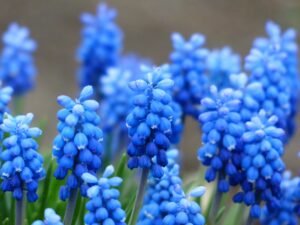
Creative Uses of Grape Hyacinths in the Garden
Grape hyacinths are versatile and can be used in various garden settings to create stunning visual effects. Here are some creative ways to incorporate them into your garden:
Borders and Edging: Plant grape hyacinths along borders and pathways to create a charming, low-growing edge. Their vibrant colors and neat habit make them perfect for defining garden spaces.
Rock Gardens: Their compact size and early bloom time make grape hyacinths ideal for rock gardens. Plant them in clusters among rocks and other low-growing plants for a naturalistic look.
Containers: Grape hyacinths are excellent for container gardening. Plant them in pots or window boxes to bring early spring color to patios, balconies, and other small spaces. Combine them with other spring bulbs and annuals for a dynamic display.
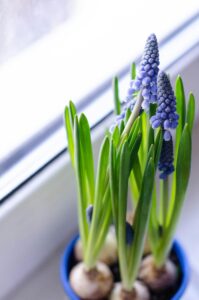
Mass Plantings: For a dramatic effect, plant grape hyacinths in large drifts or clusters. This creates a carpet of color that can be particularly striking when planted under deciduous trees and shrubs.
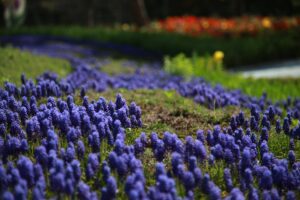
Lawns and Meadows: In some regions, grape hyacinths are used to create flowering lawns or meadows. They can be planted in grassy areas to naturalize and bloom in spring before the grass grows tall. This approach provides a charming, naturalistic look that mimics wildflower meadows.
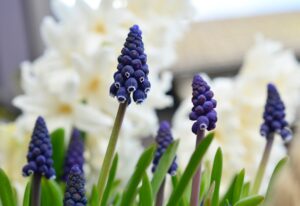
Grape hyacinths are a wonderful addition to any garden, offering vibrant early spring color and a delightful fragrance with minimal care. By following the tips and guidelines in this comprehensive guide, you can enjoy the beauty of grape hyacinths year after year. Happy gardening!
Feel free to visit our blog for more gardening tips and inspiration at My Gardens Bloom.


